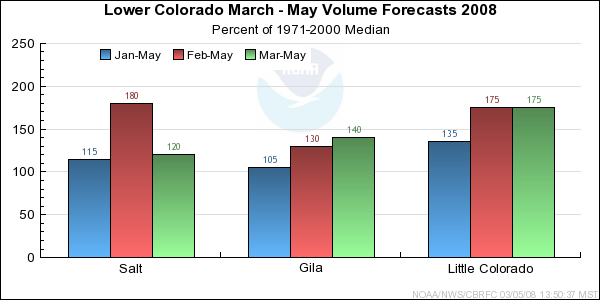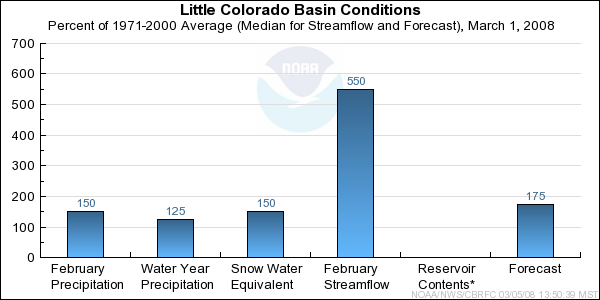Lower Colorado Water Supply Outlook, March 1, 2008
Note: This publication is scheduled for revision. If you have feedback on content, format, or publication frequency, please contact us.
Contents
Lower Colorado Summary
Above average precipitation occured in February from northern Arizona extending
to just south of the Mogollon Rim. Below average precipitation was observed over the
southern third of Arizona. Snow continued to accumulate at the highest elevations
through mid February with melt occurring during the last week of the month. Snowmelt
combined with rainfall earlier in the month resulting in February streamflow volumes
well above median for the third consecutive month. Runoff volumes for the February
through May period are expected to range from near 120 to 300 percent of median.

*Median of forecasts within each basin.
Salt Basin Conditions
March through May runoff volumes in the Salt, Verde, and Tonto River Basins are expected
to range from near 110 to 120 percent of the median. Rainfall and snowmelt runoff during
February contributed to monthly volumes between 300 to 450 percent of median. Snowpack
that remains in the highest elevations of the Salt and Verde Basins ranges from 120 to
260 percent of average. The snowpack will contribute to the seasonal runoff volumes
but areal coverage extends across a small fraction of the basin. Additional rainfall
during the March through May period may contribute significantly to runoff volumes
due to saturated conditions in this area.

* Percent usable capacity, not percent average contents.
Click for multi-month Graph.
Gila Basin Conditions
March through May runoff volumes in the Gila River Basin are expected to range from
near 120 to 250 percent of median. Monthly runoff volumes in February due to rainfall
and snowmelt ranged from 200 to 350 percent of median. Snowpack in the San Francisco
Basin high elevations ranges from 90 to 260 percent of average. Additional rainfall
during the March through May period may contribute significantly to runoff volumes
due to saturated conditions.

* Percent usable capacity, not percent average contents.
Click for multi-month Graph.
Little Colorado Basin Conditions
March through May runoff volumes in the Little Colorado Basin are expected to range from
near 120 to 270 percent of median. Monthly runoff volumes in February due to rainfall
and snowmelt ranged from near 370 to near 900 percent of median. Snowpack in the Little
Colorado southern headwaters ranges between 140 and 160 percent of average. February
precipitation amounts ranged from 130 to 180 percent of average. Additional rainfall
during the March through May period may contribute significantly to runoff volumes due
to saturated conditions.

* Percent usable capacity, not percent average contents.
Click for multi-month Graph.
Differences between the full period forecasts and the residual forecasts may not exactly equal the actual observed volumes due to rounding conventions (see Definitions section).
Precipitation Maps


Hydrologist: G. Smith







